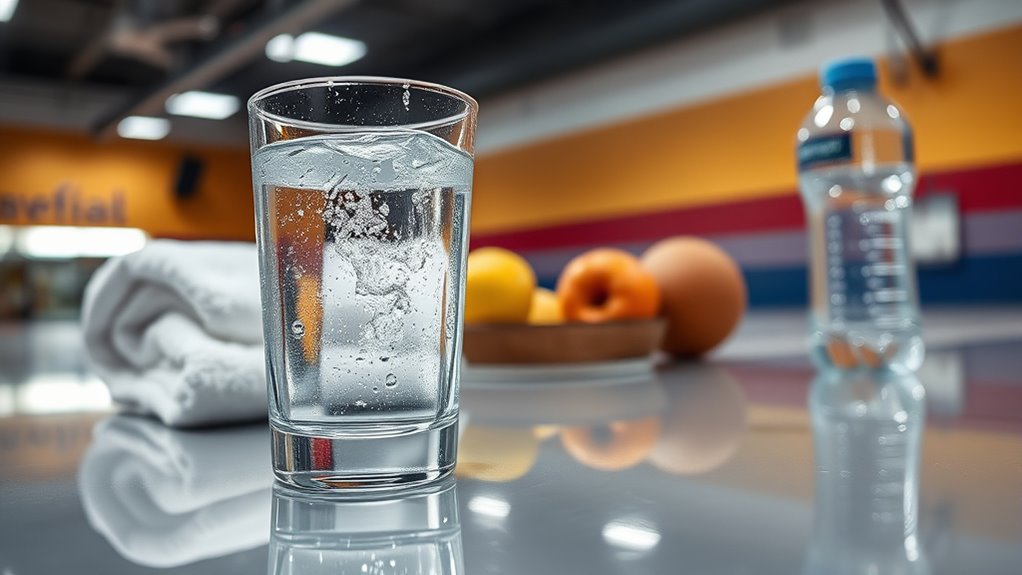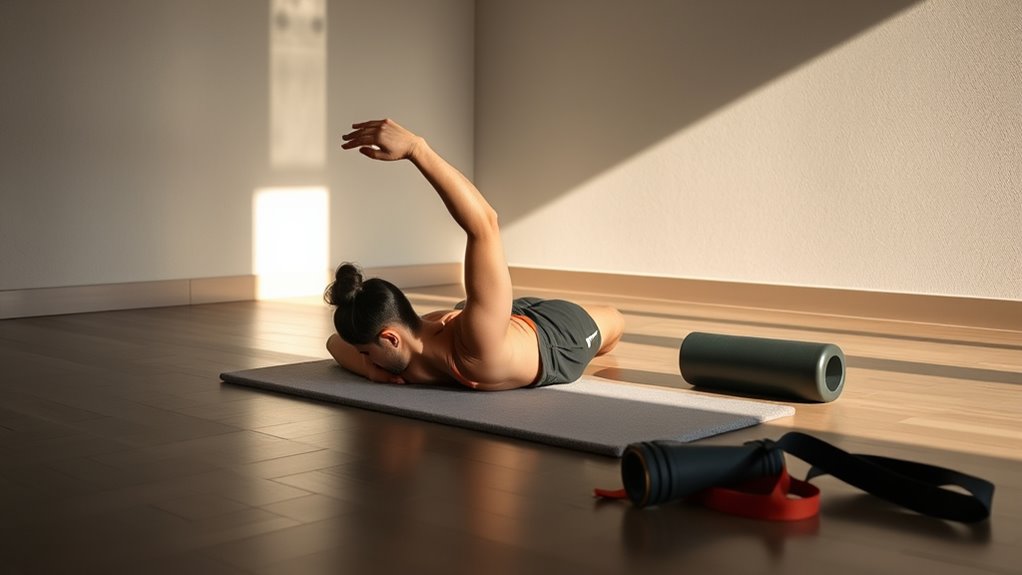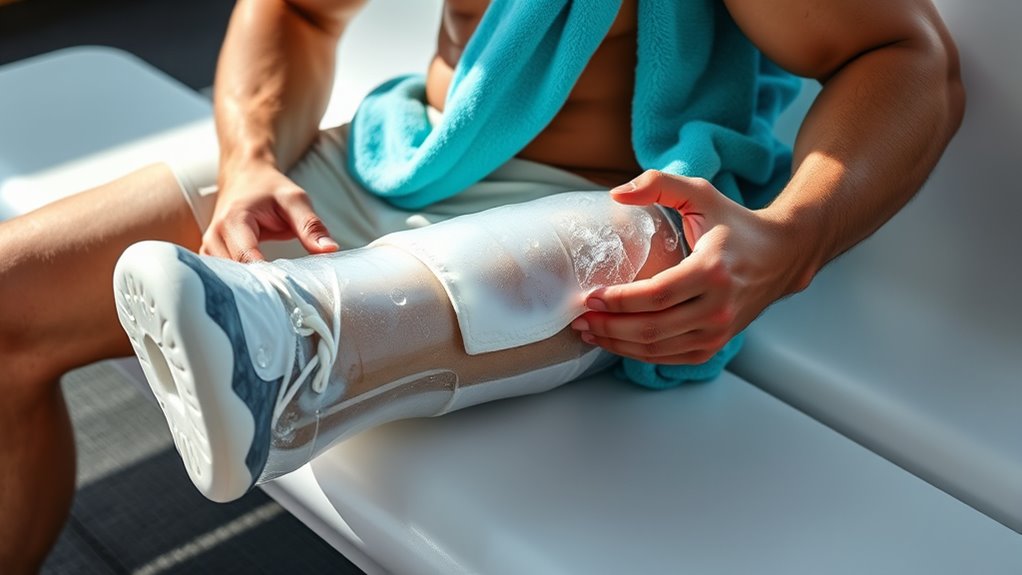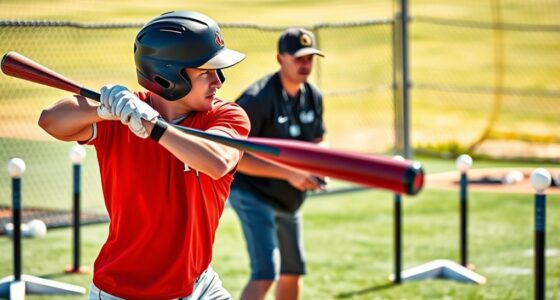After a tough game, focus on rehydrating with electrolyte drinks and refueling with carbs and protein within an hour to boost recovery. Incorporate gentle stretching and light movement to loosen muscles, and use cold therapy like ice packs to reduce inflammation. Wear compression garments to improve circulation, get quality sleep, and consider massage or foam rolling to release tension. Recognizing signs of overtraining can help you bounce back stronger—keep going to discover more tips to optimize your recovery.
Key Takeaways
- Rehydrate with electrolyte-rich drinks promptly after playing to restore fluids and support recovery.
- Consume carbohydrate and protein-rich foods within 30-60 minutes post-game to replenish glycogen and aid muscle repair.
- Incorporate gentle stretching, mobility exercises, and light movement to promote circulation and reduce soreness.
- Use cold therapy and compression garments to decrease inflammation and enhance blood flow for faster healing.
- Prioritize rest and quality sleep to facilitate muscle recovery, reduce inflammation, and prepare your body for tomorrow.
Hydrate Effectively After Playing

After playing, it’s vital to rehydrate promptly to restore fluid levels and support recovery. Focus on maintaining electrolyte balance, which is essential for muscle function and preventing cramps. Choosing the right beverage is key—water is effective, but adding electrolyte-rich drinks can enhance rehydration. Look for options with sodium, potassium, and magnesium, as these minerals help replace what’s lost through sweat. Avoid sugary sodas or caffeinated drinks, as they can dehydrate you further. Instead, opt for sports drinks or electrolyte-infused waters designed to replenish both fluids and minerals. Drinking consistently in the hours after your game ensures your body rehydrates efficiently, helping you recover faster and prepare for your next activity. Proper hydration is the foundation of a successful post-game recovery. Regularly monitoring your air quality indicators can also help you identify when your environment needs improved ventilation or purification to support overall health.
Prioritize Proper Nutrition for Recovery

To recover effectively, you need to focus on replenishing your glycogen stores and boosting your protein intake. Eating the right foods after your game helps your muscles recover faster and prepares you for future performance. Prioritizing proper nutrition makes a noticeable difference in your overall recovery process. Incorporating exotic fruit blends can also provide essential vitamins and antioxidants to support your body’s healing process.
Replenish Glycogen Stores
Replenishing glycogen stores is essential for effective recovery, as your muscles rely on these stored carbohydrates to restore energy levels. After intense activity, prioritize carbohydrate replenishment by consuming foods rich in complex carbs like whole grains, fruits, and vegetables. These help accelerate glycogen restoration, ensuring your muscles are ready for future workouts. Timing matters—aim to eat carbohydrate-rich meals within 30 to 60 minutes post-exercise to maximize glycogen synthesis. Hydration also plays a role; staying well-hydrated supports ideal nutrient absorption and recovery. Avoid neglecting this step, as inadequate glycogen replenishment can lead to fatigue and decreased performance. Incorporating top beach towns on the East Coast into your recovery routine can provide opportunities for relaxation and outdoor activity, which also aid muscle recovery. By focusing on proper carbohydrate intake, you give your body the fuel it needs to bounce back stronger for tomorrow’s challenges.
Optimize Protein Intake
Proper protein intake plays a vital role in your recovery process, supporting muscle repair and growth after intense activity. To maximize benefits, focus on protein timing—consume protein within 30-60 minutes post-game for ideal absorption. Incorporate a variety of plant-based options, like beans, lentils, tofu, and quinoa, to diversify your amino acid intake. Keep these points in mind:
- Prioritize high-quality protein sources, including plant-based options.
- Distribute protein evenly across meals to sustain muscle synthesis.
- Aim for approximately 20-30 grams of protein per serving after activity.
- Combine plant proteins to guarantee complete amino acid profiles.
Incorporate Gentle Stretching and Mobility Exercises

After a demanding game, incorporating gentle stretching and mobility exercises helps your body recover more effectively. Focus on dynamic stretching to loosen tight muscles and improve blood flow, preparing your body for rest and repair. These movements boost joint mobility, reducing stiffness and enhancing flexibility. Take time to gently stretch major muscle groups like your hamstrings, quads, and calves, moving smoothly through each motion. Incorporate simple mobility drills that target your shoulders, hips, and ankles to restore ideal joint function. Keep movements controlled and avoid overstretching, listening to your body’s signals. This routine helps prevent soreness, promotes circulation, and speeds up recovery, so you’re ready for tomorrow’s challenges. Incorporating sound vibrations into your recovery routine has been shown to enhance cellular regeneration and overall health. Consistent gentle stretching and mobility exercises are essential for a balanced, injury-free recovery process.
Use Ice and Cold Therapy to Reduce Inflammation

Applying ice or cold packs can considerably reduce inflammation and numb soreness after your workout. To get the best results, make sure you use proper application techniques, like wrapping the cold source in a cloth and limiting sessions to 15-20 minutes. Understanding the benefits and correct methods helps you recover faster and avoid skin damage. Using expert voice actors in your approach can also enhance the effectiveness of your recovery communication.
Cold Therapy Benefits
Cold therapy, such as applying ice packs or cold compresses, effectively reduces inflammation and alleviates soreness after intense activity. It promotes cold immersion, which helps constrict blood vessels through vasoconstriction benefits, decreasing swelling and tissue damage. Additionally, using cold therapy can improve overall color accuracy by minimizing tissue swelling that may distort sensory signals. Here are four key benefits:
- Accelerates recovery by limiting inflammation.
- Reduces muscle soreness and stiffness.
- Enhances vasoconstriction, controlling blood flow and swelling.
- Supports mental clarity by providing a invigorating, numbing effect.
Proper Application Techniques
To effectively reduce inflammation with ice and cold therapy, it’s essential to use proper application techniques. Start by wrapping ice or a cold pack in a thin towel to prevent skin damage, ensuring proper technique application. Apply the cold pack to the affected area for 15-20 minutes, and avoid direct skin contact to prevent frostbite. Repeat this process every 1-2 hours during the first 24-48 hours after injury or intense activity. Be mindful not to overuse cold therapy, as prolonged exposure can hinder blood flow and delay healing. Proper application techniques are crucial for optimal recovery and injury prevention, helping you recover faster and reducing the risk of further damage. Additionally, understanding brain health foods can support your overall recovery and mental clarity during the healing process.
Employ Compression Garments to Enhance Circulation

Using compression garments after a workout can considerably boost circulation, helping your muscles recover faster. This technique, known as compression therapy, promotes circulation enhancement by applying gentle pressure on your limbs. To maximize benefits, keep these tips in mind:
Boost circulation and speed recovery with compression garments worn immediately after workouts.
- Choose the right compression level for your activity and comfort.
- Wear the garments immediately post-exercise for ideal circulation benefits.
- Ensure proper fit; too tight can restrict blood flow, too loose reduces effectiveness.
- Use them consistently during recovery days to maintain circulation flow.
- Incorporating Kia Tuning techniques can also optimize recovery by improving overall vehicle performance, which parallels the benefits of optimized recovery methods for your body.
These practices support faster removal of metabolic waste and reduce swelling. By employing compression garments correctly, you enhance circulation and accelerate muscle recovery, preparing you better for your next workout.
Rest and Sleep: Key Components of Recovery

After wearing compression garments to improve circulation, giving your body adequate rest and sleep becomes essential for peak recovery. Prioritize sleep hygiene by maintaining a consistent sleep schedule, minimizing screen time before bed, and creating a cool, dark environment. Short naps can boost recovery; try strategies like the 20-minute power nap or a 90-minute full sleep cycle to recharge. Rest helps repair muscles, reduce inflammation, and restore energy. Incorporate research-backed insights to optimize your sleep routines and enhance overall recovery. Use the table below to visualize your post-game rest routine:
| Rest Strategies | Imagery |
|---|---|
| Consistent sleep | Falling asleep easily at the same time daily |
| Nap timing | Catching a quick 20-minute recharge |
| Sleep environment | Dark, cool, and quiet room |
| Sleep hygiene | Avoiding caffeine before bed |
| Recovery sleep | Waking refreshed and ready to go |
Prioritize quality sleep for ideal recovery.
Practice Active Recovery Techniques

Engaging in active recovery techniques can markedly enhance your post-game rebuild by promoting blood flow, reducing muscle soreness, and speeding up the healing process. Incorporate these strategies to optimize recovery:
- Perform light stretching routines to loosen tight muscles and improve flexibility.
- Incorporate gentle movement like walking or cycling to keep blood circulating.
- Practice meditation techniques to calm your mind and reduce stress, aiding overall recovery.
- Use breathing exercises to enhance oxygen flow, helping your body repair faster.
- Utilizing protective styling benefits can also help minimize further muscle strain and prevent injury during recovery.
These methods not only support physical healing but also promote mental relaxation. By actively engaging in these recovery practices, you’ll prepare your body for future performance and minimize fatigue. Consistency in applying active recovery techniques makes a significant difference in bouncing back stronger.
Use Massage and Foam Rolling to Release Tension

Massage and foam rolling are effective tools for releasing muscle tension and speeding up recovery after a game. They help break up knots and reduce soreness through targeted pressure. Incorporate self-massage techniques to address specific areas that feel tight or tender. Trigger point therapy, a form of self-massage, involves applying sustained pressure to tender spots to relieve pain and restore muscle function. Use a foam roller to systematically roll over muscles, focusing on tight areas like your quads, hamstrings, and calves. This process increases blood flow and promotes faster healing. Consistent use after games can prevent stiffness and improve flexibility. Keep your movements controlled, and avoid rolling over joints or bony areas to prevent injury. Regular self-massage with foam rolling and trigger point therapy optimizes recovery and prepares you for tomorrow’s challenge.
Monitor Your Body and Recognize Signs of Overtraining

Monitoring your body is key to avoiding overtraining and ensuring ideal recovery. Pay close attention to signs of fatigue, as they often indicate your training intensity might be too high. Recognize these signals early to prevent setbacks. Here are four ways to stay alert:
- Notice persistent soreness or aches beyond normal post-exercise discomfort.
- Track your energy levels; constant tiredness signals overtraining.
- Observe your mood; irritability or lack of motivation can be signs of burnout.
- Monitor sleep quality; poor rest may reflect excessive training stress.
Frequently Asked Questions
How Long Should I Wait Before Resuming Intense Workouts?
You should wait at least 24 to 48 hours before resuming intense workouts, depending on your fatigue and soreness levels. Focus on proper nutrition timing by eating a balanced meal with carbs and protein within an hour after exercise to support recovery. Hydration importance cannot be overstated; drink plenty of fluids to replenish lost electrolytes. Listen to your body, and don’t rush back if you’re still feeling tired or sore.
Can Supplements Enhance Post-Game Recovery?
They say, “You are what you eat,” and supplements can play a role in your recovery. While they shouldn’t replace solid nutrition plans, supplements like protein or electrolytes can enhance your hydration strategies and support muscle repair. Just remember, proper nutrition and hydration are the foundation. Use supplements wisely, and always consult a professional to guarantee they complement your recovery and help you bounce back stronger for tomorrow.
How Do I Know if I’M Overtraining?
You’ll know you’re overtraining if muscle soreness lingers longer than usual, you feel unusually fatigued, or notice a decline in performance. Pay attention to your body’s signals and maintain proper hydration strategies to help recovery. If rest doesn’t alleviate soreness or fatigue, consider taking a break or reducing intensity. Listening to your body is key to preventing overtraining and ensuring you stay balanced in your training routine.
What Are the Best Recovery Techniques for Chronic Injuries?
Chronic injuries demand careful attention, yet recovery can be both gentle and effective. You should incorporate gentle stretching routines to improve flexibility without aggravating pain, while foam rolling helps release muscle tension and enhance blood flow. Unlike aggressive treatments, these techniques provide a soothing approach, allowing your body to heal naturally. Consistency is key; combined with rest and proper medical guidance, they can markedly aid your recovery process.
Is It Necessary to Consult a Professional for Recovery Strategies?
You should definitely consider consulting a professional for recovery strategies, especially if your resting habits or mental health are affected. A specialist can tailor a plan that addresses your specific needs, helping you recover safely and efficiently. Relying solely on general advice might overlook underlying issues. Prioritizing expert guidance ensures you get personalized support, which is vital for both physical healing and maintaining mental well-being.
Conclusion
Remember, your recovery is the bridge between games, fueling your next victory. By staying attentive to your body and following these tips, you’ll bounce back faster than a rubber ball. Think of recovery as watering a plant—you need to nurture it consistently to see it thrive. So, take care of yourself today, and tomorrow’s performance will be brighter than ever. Your best game starts with a strong, well-recovered you.









